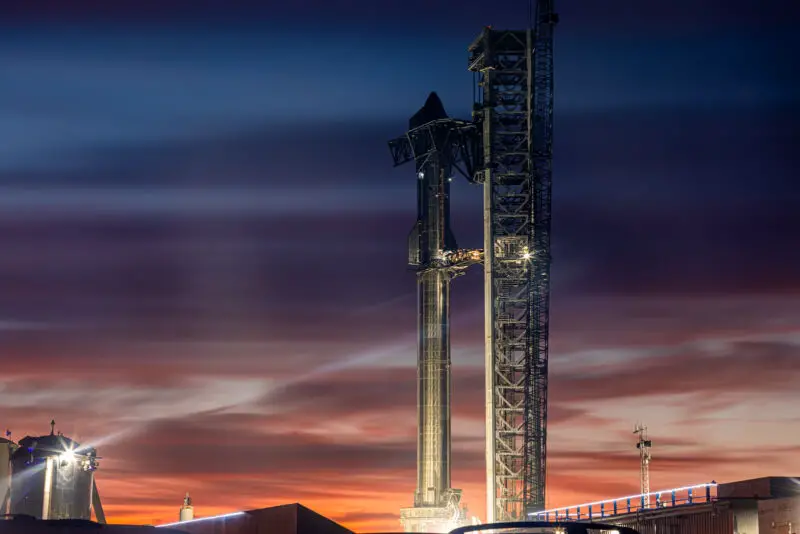For the second time in history, SpaceX has utilized the ‘Mechazilla’ tower and arms from Starbase to stack an upper stage of a Starship rocket on top of a Super Heavy launch.
Although SpaceX definitely learned a great lot from its second Starship stack on February 9th, the company was able to finish the stacking procedure many times quicker on March 15th, demonstrating that it has improved over time. It took SpaceX about three and a half hours from the commencement of the lift to the point when Starship was entirely resting on Super Heavy on the second attempt, depending on how one calculates time. SpaceX, on the other hand, was able to lift, translate, lower, and connect the Starship to the Super Heavy in less than an hour using Stack #3.
In an unusual turn of events, SpaceX accomplished this achievement without the use of a claw-like mechanism intended to catch and support Super Heavy during stacking operations. In Stack #2, all three arms were completely engaged in the game. For starters, a pair of ‘chopsticks,’ which are huge arms designed to pick up, hoist, and even retrieve spacecraft and boosters, grabbed Ship 20 and raised it close to 100 meters (300 feet) above the ground, rotated it on top of Super Heavy, and temporarily halted the action. A third arm – known as the ship quick-disconnect or umbilical arm – swung in and extended its ‘claw’ to grip onto hardpoints near the top of Super Heavy, where it remained for the rest of the battle. Once the booster was in place, the ‘chopsticks’ were used to carefully drop Ship 20 onto Booster 4’s interstage, where six clamps were used to link the two stages together to complete the mission.
The umbilical device positioned on the swing arm of Ship 20 was extended and linked to Ship 20 a few hours after the two were clasped together. Although it is unknown whether or not the panel was really utilized, the umbilical is intended to link the Starship to ground systems in order to give fuel, electricity, communications, and other consumables to the ship. Regardless, the gadget seemed to have established a connection with Starship. The swing arm’s ‘claws’ were removed before to Stack #3, which meant that the spacecraft had no ability to grip onto Super Heavy after that. Given that Stack #1 was finished three times quicker than Stack #2, it seems that the reduced capability had no effect on the ease or speed with which the stacking procedure was performed.
That might indicate that the claw is either wholly superfluous or is only required while performing stacking operations in high gusts, depending on your perspective. What is evident is that the claw removal most likely only saved a few minutes on the whole stacking time, not the entire procedure. Stack #3 was much quicker because of a faster lift and fewer stops throughout – particularly while dropping Starship the last few meters onto Super Heavy. During Stack #2, it took over an hour and a half for SpaceX to completely descend Ship 20 to the ground. Stack #3 only took around 20 minutes to complete the same procedure.
After an exceptionally quick one-hour stack, it took SpaceX over two hours to attach the swing arm’s umbilical to the spacecraft, indicating that there is still potential for improvement. It is possible that Starbase’s orbital launch integration system is already capable of supporting multiple Starship launches per day, assuming SpaceX can speed up the start of the stacking process and replicate its Starship success with Super Heavy, which will also need to be grabbed and installed on an even more complex launch mount, as well as multiple Starship launches per day. In any case, SpaceX has not yet shown that the orbital launch site can be turned around in a few hours after having been exposed to the violence and strains of a Starship launch mission.
Possibly more crucially, SpaceX has never attempted a Starship launch, recovery, or reuse in space until now. As a result, the corporation finds itself in the rare situation of having to create and test costly, specialized support equipment before knowing whether or not the rocket that the equipment is meant to assist will be able to take benefit of it. Only the Space Shuttle comes close to matching the size of Starship in terms of orbital spacecraft, and NASA’s all-time record for orbiter turnaround is 54 days. Despite the fact that SpaceX has officially flown two Falcon 9 rockets twice in 27 days, reusing a significantly smaller suborbital booster is far simpler than recycling a gigantic orbital spaceship, which is why the company is focusing its efforts on that.
It is not really SpaceX’s fault that the company is still waiting for clearance to conduct orbital test flights at this point. Although the growing maturity gap between the Starship and Super Heavy rockets, as well as the orbital launch site designed to support them, raises the possibility that SpaceX will be forced to completely redesign the rocket, as well as its support equipment if significant problems arise during orbital test flights.
There is a chance that SpaceX will attempt to crushproof Starship while it is perched atop Super Heavy – or even both stages at the same time. The orbital launch site’s propellant storage and distribution system have been used to crushproof Ship 20 and Booster 4, but SpaceX has not fully tested the hardware required to route hundreds of tonnes of propellant hundreds of feet into space – a requirement for full-stack testing and launch operations.

